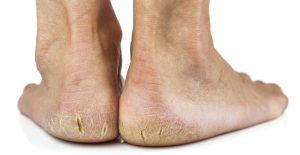General Podiatry
Podiatrists manage a wide range of conditions. From simple nail cutting because you can’t reach or have trouble cutting your own toe nails to ingrown toe nail surgery.
Corns and Calluses

Calluses are a build up of hard skin which is caused by increased pressure. This increased pressure may be as a result of the way you walk or run, abnormal foot posture, toe deformities, joint conditions or unsuitable footwear.
Corns are usually found under callus. They are a small, hard area of skin that have a core. Corns may cause pain when pressure is applied. Hard corns are generally form on the bottom of your feet or on the tops of your toes. Soft corns are usually found between the toes. They are white and rubbery bumps of skin. Corns are often mistaken for warts. If you suspect you have a wart or corn you should see your podiatrist for assessment.
Removal of corns and callus is simple and fast. It is generally pain free. Your podiatrist will also provide you with education on how to prevent future development.
Thickened and deformed nails
Thickened and deformed nails can be as a result of trauma or fungal infections (onychomycosis). Podiatrists can help identify the cause of your nail pathology by simple observation or take nail samples to send to pathology for diagnosis. Most people are embarrassed to show their funny toenails. Don’t be afraid to show your podiatrist. Podiatrists see these conditions day in and day out and are more than happy to help.
Your podiatrist can reduce the thickness of your nail with special instruments and discuss suitable anti-fungal treatment options.
Skin conditions or ‘smelly feet’
Skin conditions such as tinea pedis or athletes foot, pitted keratolysis, dermatitis and psoriasis are common conditions your podiatrist can help you with. Your podiatrist will help work out why you might be suffering from these conditions and discuss the most suitable management options for you.
Warts
- skin lesions caused by the human papillomavirus (HPV)
- commonly contracted when walking around barefoot in public moist environments such as swimming pools, change rooms and showers
- can cause pain and discomfort and may alter standing foot position and walking. This can progress to further foot and symptoms if left untreated.
- they can spread to other sites on the foot
- contagious – can spread to other family members
- your podiatrist can manage the wart lesion as well as discuss home treatments and preventative measures to avoid re-infection and spread
